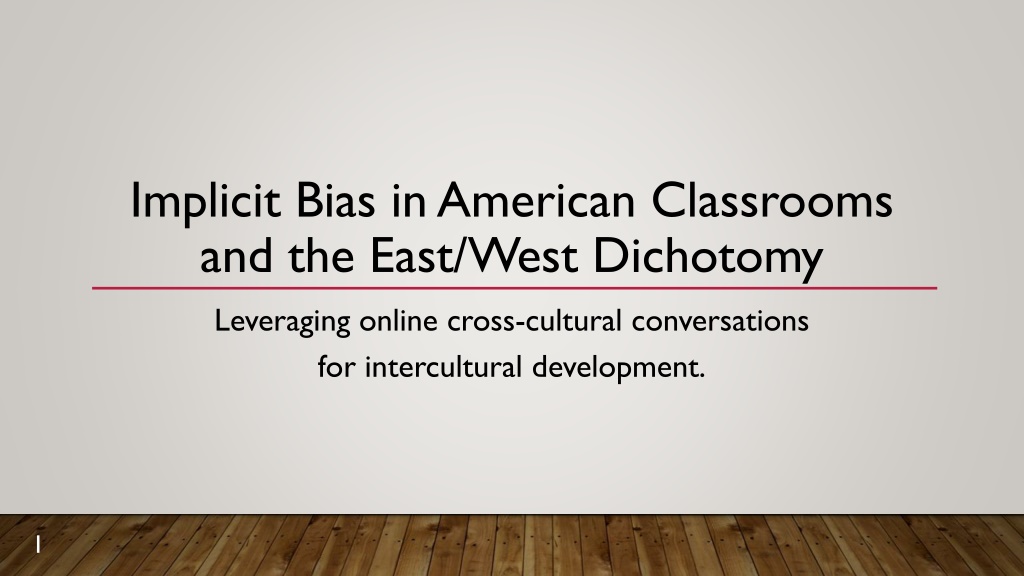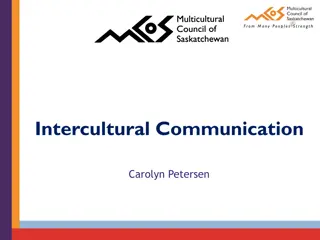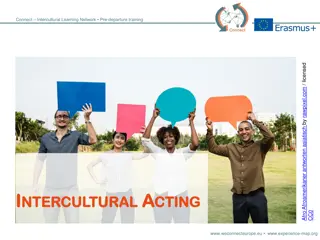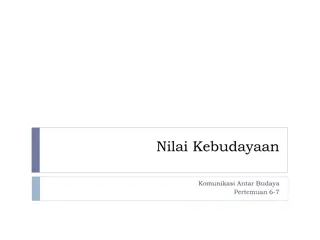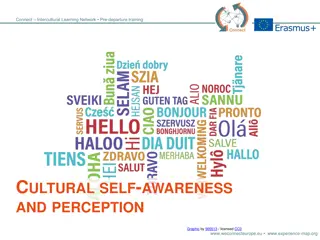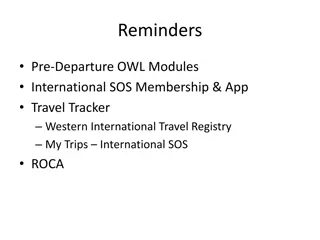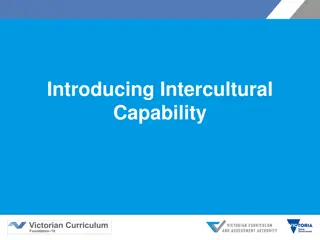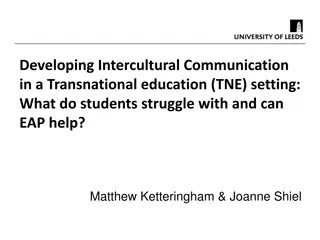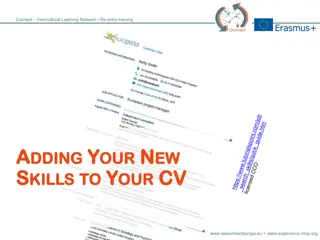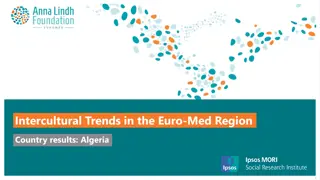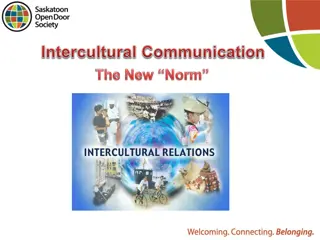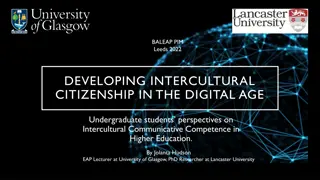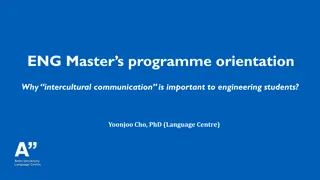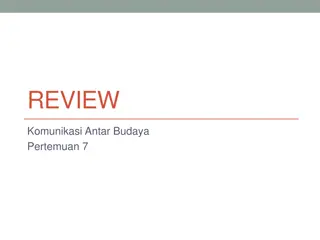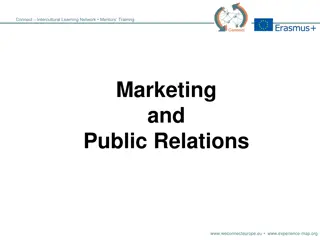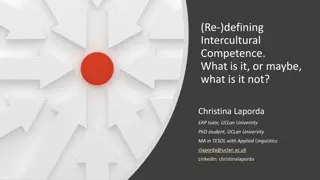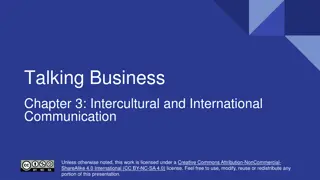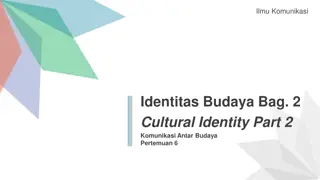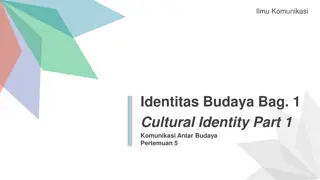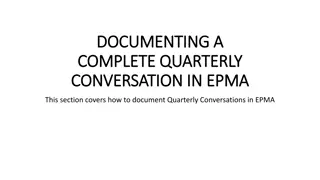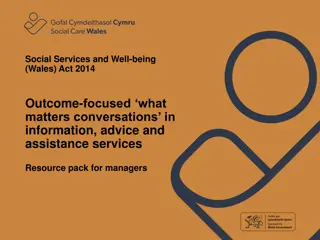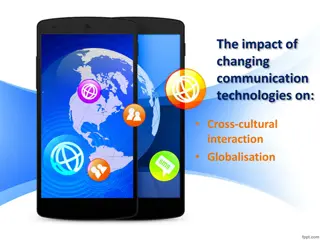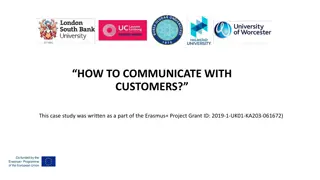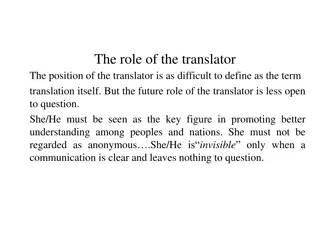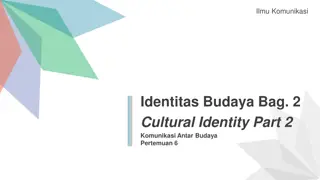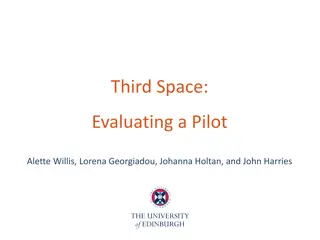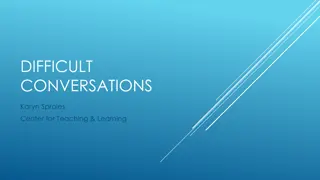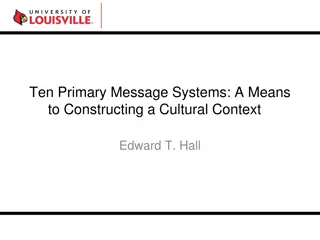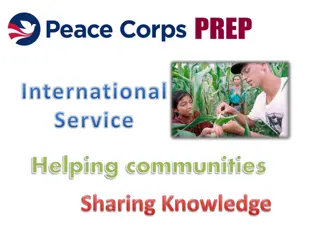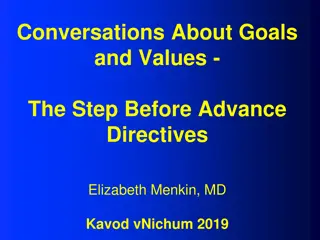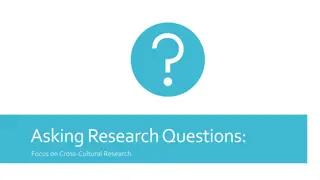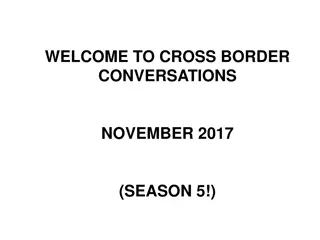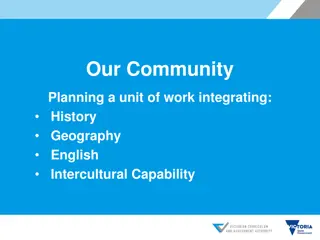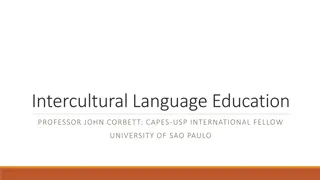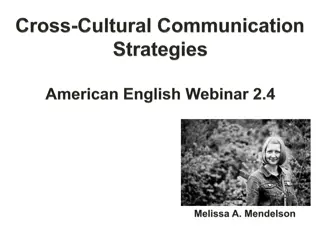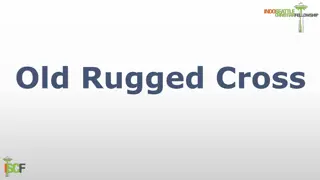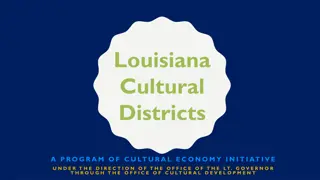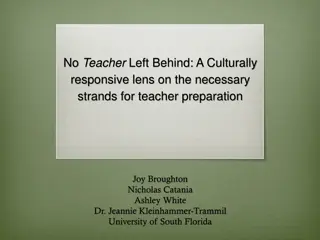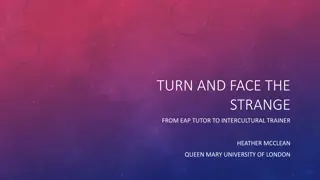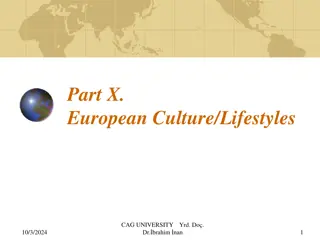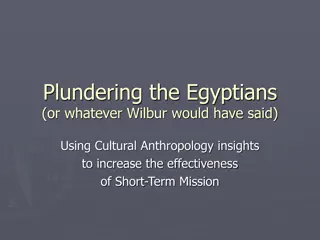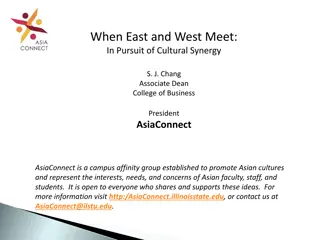Leveraging Online Cross-Cultural Conversations for Intercultural Development
This presentation highlights the utilization of online discussions between OSU students and students from a Turkish university to address cultural bias and enhance cross-cultural communication skills. By exploring challenging topics related to identity and belonging, students engage with diverse perspectives, problematizing the dichotomy between East and West. The focus on authenticity and sustained interactivity fosters intercultural learning by encouraging students to reflect on their cultural identities and interact with others from different backgrounds.
- Cross-cultural conversations
- Intercultural development
- Online discussions
- Cultural bias
- Challenging topics
Download Presentation

Please find below an Image/Link to download the presentation.
The content on the website is provided AS IS for your information and personal use only. It may not be sold, licensed, or shared on other websites without obtaining consent from the author. Download presentation by click this link. If you encounter any issues during the download, it is possible that the publisher has removed the file from their server.
E N D
Presentation Transcript
Implicit Bias in American Classrooms and the East/West Dichotomy Leveraging online cross-cultural conversations for intercultural development. 1
Introduction: What we are going to cover and why. In the context of the COVID-19 pandemic and social and political turmoil of the 2020-2021 academic year,we leveraged online discussions between OSU students and students at a Turkish university in order to explicitly address cultural bias and develop cross-cultural communication skills. We found that a focus on authenticity and sustained interactivity was effective in helping students engage with difficult topics. We addressed the implicit bias that students at American universities often have: a view of the West as central to the world and the East as Other. We facilitated discussions that helped students learn about themselves as cultural beings and engage with diversity in order to problematize this dichotomy. In this presentation, we will share some of out discussion prompts that utilize the latest research on online community building. We will discuss how these prompts direct the learning toward both intercultural and global development. We will delve into: What is intercultural learning? What kind of online classroom activities and assignments does it entail? 2
What is Intercultural Learning? Intercultural learning means students are gaining an awareness of themselves as cultural beings and learning to expect complexity when dealing with other cultures. Intercultural learning entails a growth mindset (it s never complete). Intercultural development emphasizes practical applications, like how to interact with people from different cultures, where the values, norms, and expectations of the relationship and interactions are not pre-supposed or assumed. 3
What makes OUR learning activities intercultural? Students explore Self and Other as they are represented in texts and images. Students begin to perceive the effects of culture on their own and other communities and acknowledge the way culture has shaped their personal worldview and the worldviews of others. Students receive immediate feedback on discussion forums with students who live day-to-day in the culture they are studying and reflect on their own culture from contrasting experiences. 4
Addressing Challenging Topics from Insider/Outsider Points of View Topics related to identity and belonging require sensitivity: Imperialism Nationalism Democracy Conflict Representation Minority/ Human Rights 5
Assignment: Insider/Outsider Representations This assignment is the beginning of a semester-long conversation about nationalism and what it means to be Turkish (and American or any other nationality), and the effects of leaving certain members of society out of the national narrative. This lesson can also be the beginning of ongoing conversations about the East/West dichotomy and the politics of being situated in one or the other. The students may not show much growth at this early stage of the class but will begin the process of considering themselves as others too. 6
Scaffolding Before class: Read texts written by authors from both inside and outside of Turkey. Answer reflection questions about the difference in perspectives. In-class: Watch and analyze tourism videos from a critical standpoint, considering East/West constructs, traditional/modern constructs, stereotypes, etc. Discuss: Common stereotypes about Turkey, Muslims, and the Middle East. Challenge the naturalness of national origin narratives. Online Forums: Students are ready to ask informed questions and actively seek critical feedback from their peers in Turkey. 7
National Identity and Belonging in the U.S. Consider: What is the American national origin story? Who are the heroes of that story? What symbols of national identity and belonging do we use in the U.S.? What activities do we participate in that renew a sense of national unity and solidarity? What groups might be underrepresented in this story, with these symbols, and in these activities? 8
National Identity and Belonging in Turkey National origin story WWI and the Ottoman Empire Enemies on all sides Internal enemies The Republic of Turkey was founded in 1923 Turkish speaking Sunni Muslims Hero: Mustafa Kemal Ataturk 9
Symbols First president of Turkey, Mustafa Kemal Turkey s Flag 10
Activities Futbol National holidays National anthem Student oath 11
Student Oath T rk m, do ruyum, al kan m. Yasam, k klerimi korumak, b y klerimi saymak, yurdumu, milletimi z mden ok sevmektir. lk m y kselmek, ileri gitmektir. Varl m T rk varl na arma an olsun. Ey bu g n m z sa layan, Ulu Atat rk; a t n yolda, kurdu un lk de, g sterdi in ama ta hi durmadan y r yece ime ant i erim. Ne mutlu T rk m diyene. I am Turkish, honest and hardworking. My principle is to protect the younger, to respect the elder, to love my homeland and my nation more than myself. My ideal is to rise, to progress. My existence shall be dedicated to the Turkish existence. O Great Atat rk, who had created our life of today; on the path that you have paved, in the country that you established, I swear to walk incessantly with the purposes that you have set. How happy is the one who says "I am Turkish." 12
I Am Turkish Kurds Christians Roma Alevis Laz LGBTQ Jews 13
I Am American Decapitated Statue of Christopher Columbus in Boston, 2020 Colin Kaepernick Taking a Knee 14
East/West Relations between countries, for example Turkey and the U.S. What does it mean to be Western ? What does it mean to be Eastern ? Is the U.S. in the East or West? Is Turkey in the East or West? Turkey as a bridge 15
In-class Activity: Watch and Discuss Discovery Channel s Flavor of Turkey video (youtu.be/auDyTT9EWrI) As you watch: Write down some of the words or phrases you hear used to describe Turkey. Describe the images that are used to portray Turkey. Note any sounds you hear in the video, like music, and the effect it has on you. 16
Discuss What impressions do you get? If you only watched this film and had never been to Turkey, what would you expect to find there? Do you see the East or West portrayed in the images in the film? Why do representations sometimes emphasize foreign, exotic, or "other" aspects of society and physical surroundings? History is valued in Turkey, but it is also how Turkey is sold to tourists two different motives operating at the same time. How does this complicate representations of Turkey? The video doesn't emphasize class issues, poverty, or political turmoil. But it tells us about representation and how it works. What did they choose to show and not to show? Why? What would you include in a tourist video about the U.S.? 17
Resume Builders for students Intercultural Development Inventory provides an assessment of intercultural awareness and individualized next steps for continued growth. Global Competence Certificate (GCC) (globalup.com) Collaborations Students can point to the collaborative activities in the class as authentic cross-cultural experience. Beyond Harems and Belly Dancers: Turkish Culture (go.osu.edu/turkishculturecourse) 18
Your questions and comments are welcome! 19
Thank You Cindy Jiang The Ohio State University, Office of International Affairs Department of Near Eastern Languages and Cultures Middle East Studies Center Drake Institute for Teaching and Learning 20
